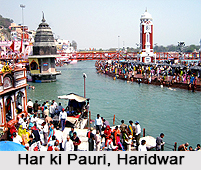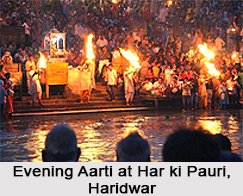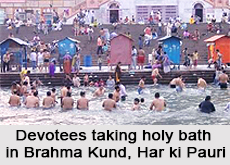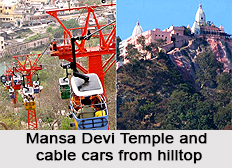 Haridwar is the heart of the pilgrimage centres of Uttarakhand. The city and municipality of Haridwar in the Haridwar district of Uttarakhand state, is one of the most prominent Hindu pilgrimage destinations since time immemorial. The name itself indicates the place as the Gateway to God, being a concoction of Sanskrit words "Hari" referring to Lord Vishnu and "dwara" meaning gate or gateway. It is also spelt as Hardwar, incorporating "Hara" as Lord Shiva in Sanskrit. It is also referred to as "Gangadwara", its ancient name given the fact that the holy Ganges River, after traversing 253 kilometres from its origin at Gaumukh, descends to the Indo-Gangetic plains of North India for the first time at Haridwar. This is one of the seven holiest cities for Hindus in India, referred by them as the "Sapta Puri". It has also been referred to as "Mayapuri Kshetra" in the Indian Puranas. The religious relevance of Haridwar makes the city completely vegetarian and alcohol free.
Haridwar is the heart of the pilgrimage centres of Uttarakhand. The city and municipality of Haridwar in the Haridwar district of Uttarakhand state, is one of the most prominent Hindu pilgrimage destinations since time immemorial. The name itself indicates the place as the Gateway to God, being a concoction of Sanskrit words "Hari" referring to Lord Vishnu and "dwara" meaning gate or gateway. It is also spelt as Hardwar, incorporating "Hara" as Lord Shiva in Sanskrit. It is also referred to as "Gangadwara", its ancient name given the fact that the holy Ganges River, after traversing 253 kilometres from its origin at Gaumukh, descends to the Indo-Gangetic plains of North India for the first time at Haridwar. This is one of the seven holiest cities for Hindus in India, referred by them as the "Sapta Puri". It has also been referred to as "Mayapuri Kshetra" in the Indian Puranas. The religious relevance of Haridwar makes the city completely vegetarian and alcohol free.
Pilgrimage Tourism in Haridwar, Uttarakhand
Haridwar is the gateway to the "Char Dham Yatra" of Uttarakhand, the religious tour covering the four pilgrimages of Gangotri, Yamunotri, Badrinath and Kedarnath. The city has numerous small and big temples scattered across the streets. Most of these temples are dedicated to Lord Shiva and Lord Vishnu.
Legend says that Prince Bhagirath performed penance here to salvage his ancestors" souls. They were perished by the curse of sage Kapil. The penance was answered with the River Ganga trickling forth from Lord Shiva`s locks, its bountiful waters reviving the sons of King Sagara. Following this legend, pious Hindu devotees stand in the sacred waters and pray for salvation of their ancestors.
Har Ki Pauri
According to the Samudra manthan, Haridwar along with Ujjain, Nasik and Allahabad is one of the four sites where drops of "Amrit", the elixir of immortality, accidentally spilled over from the pitcher while being carried by the celestial bird Garuda. This is manifested in the Kumbha Mela, the largest religious gathering of Hindus and also the largest religious fair in the world, which is celebrated once in every 12 years in these places. The Haridwar Kumbha Mela attracts millions of Hindu pilgrims, devotees and tourists from all over the world. The main ritual is to take a bath in the holy waters of the Ganga River, which is done to wash away all the sins and attain "moksha" (freedom from the cycle of birth and death). The Brahma Kund is the most sacred ghat in Haridwar, as it is believed to be the very spot where the "Amrit" fell. And this is located in Haridwar at "Har ki Pauri", literally, footsteps of the Lord. The evening prayers offered here to the Ganga are an enchanting experience to a pilgrim. A vibrant display of sound and colour is seen after the rituals; when pilgrims float flame-lit lamps and incenses over the river, commemorating their deceased ancestors. People make it a point to attend the prayers on their visit here.
Chandi Devi Temple
The Chandi Devi Temple in Haridwar is dedicated to Goddess Chandi who sits atop the Neel Parvat on the eastern banks of Ganga. It is one of the most religious places in Haridwar and can be accessed following a 3 kilometre trek from Chandi Ghat or through a ropeway from the Gauri Shankar Temple.
Maya Devi Temple
The Maya Devi Temple dates back to the 11th century. It has a carving of the 3-headed Durga and the idols of Bhairava and Shiva. It is said to be the place where the heart and navel of Goddess Sati had fallen. Dedicated to the power of Goddess, it is to the east of Har ki Pauri.
Mansa Devi Temple
The Mansa Devi Temple is atop the Bilwa Parvat on the Sivalik Hills. It is dedicated to Goddess Mansa Devi, daughter of Lord Shiva. The temple is the tower of the Haridwar city, overlooking it, symbolising a devoted mother looking after her beloved children. It houses two statues of the Goddess, one having 3 mouths and 5 arms while the other with 8 arms. A striking visual of the city can be captured from here, which makes it a popular tourist destination, with the cable cars that offer a picturesque view. It is said that the desires of worshippers are fulfilled here by the Goddess.
Kankhal
The Kankhal town houses the Daksha Mahadev Temple in its south. According to Hindu texts, King Daksha Prajapati, father of Sati, Lord Shiva`s first wife, performed a "yagya", to which he deliberately did not invite Lord Shiva. When she arrived uninvited, Lord Shiva was further insulted by the king, which infuriated Sati and she self-ignited herself in the yagya kund. King Daksha was later killed by Shiva"s deity form Virabhadra, born out of Shiva`s anger, but was brought back to life and given a goat`s head by Shiva. The temple is a tribute to this legend.
"Sati Kund" is another well known mythological site situated in Kankhal, worth a visit. Legend has it that Sati ignited herself in this kund.
Other such religiously relevant temples in Haridwar include the Pawan Dham Temple, the newly built Vaishno Devi Temple, the Gauri Shankar Temple and the eight-storeyed Bharat Mata Temple, dedicated to Mother India.
Besides the aforementioned temples, there are quite a few other spiritual places in Haridwar. These include the pilgrim lodging places or "ashrams" like the Jairam Ashram, Sapta Rishi Ashram and Sapta Sarovar, Anandamayi Maa Ashram, Kanva Rishi Ashram and Ramanand Ashram.
Other Aspects of Tourism in Haridwar, Uttarakhand
Apart from the pilgrimage centres, there are a few adventurous spots in Haridwar. One of them is the Rajaji National Park and Tiger Reserve. It is an amalgam of three former wildlife sanctuaries, inhabited by a myriad range of wildlife species such as chital, sambar, tigers, elephants, gorals, barking deer, hog deer, leopard cat, jungle cat, nilgai, wild boar, sloth bear, striped hyenas, jackals, Indian porcupine, python and others. The 315 species of birds prominently comprise pea fowl, vultures, woodpeckers, kingfishers and others.
Another notable facet of tourism in Haridwar is shopping. Shopping is popular here in the markets in Bara Bazar, Moti Bazar, Government Handloom and Handicraft Emporium, Kankhal and Jwalapur. Apart from religious and devotional items, the markets here also cater garments, food delicacies, travel goods, woollens and souvenirs.
The Gurukul Kangri University in Kankhal houses an archaeological museum displaying rare coins, paintings, manuscripts and artefacts dating back till the Harappa period.
 Visiting Information on Haridwar, Uttarakhand
Visiting Information on Haridwar, Uttarakhand
The tourist-thronged city of Haridwar can be accessed by all conventional means.
By Air: Jolly Grant Airport of Dehradun is the nearest domestic airport to Haridwar, at approximately 35 kilometers distance. The nearest international airport is Delhi"s Indira Gandhi International Airport.
By Rail: Haridwar has a railway station of its own well linked with almost all the major railheads in Kolkata, Delhi, Mumbai, Patna, Gaya, Varanasi and others. Trains are the major source of tourist inflow in Haridwar.
By Road: The National Highway 58 from Delhi to Mana Pass crosses the city. Buses are also available from major cities like Delhi, Dehradun, Agra, Lucknow and Jaipur.
Best Time To Tour Haridwar, Uttarakhand
Although the temperate climate of Haridwar makes it an all year round destination, the ideal time to visit the holy city is between the months October and April.



















